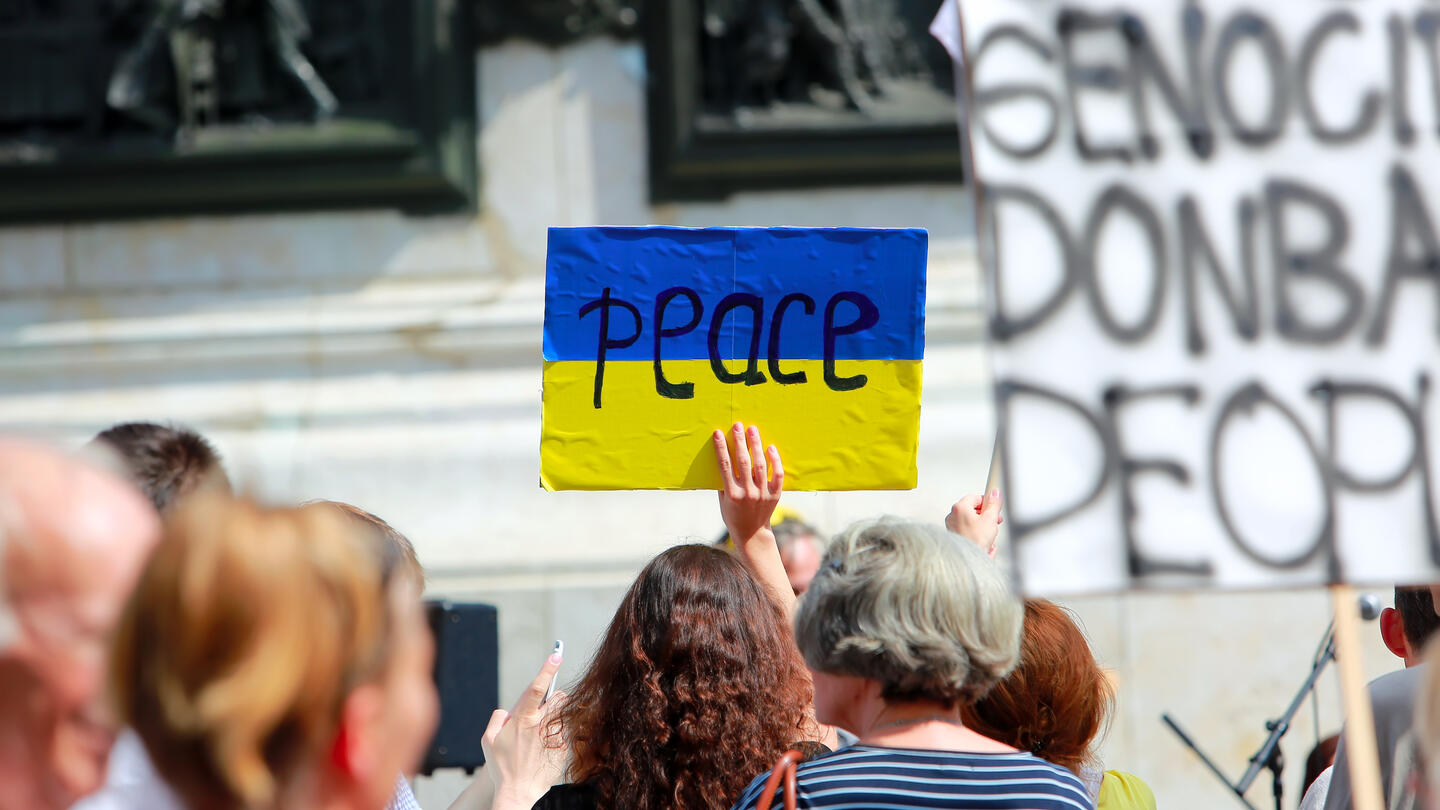When Russia first invaded Ukraine in February 2022 there was nearly unanimous bipartisan support for arming Ukraine. Now, nearly two years later, the reality is a bit more complicated. With media attention focused on many areas of the world at once, it can be hard to know how best to stay informed. Here, Reid Smith, vice president of foreign policy at Stand Together, offers a lens and framework through which one might better consider the ongoing war in Ukraine.
“The counteroffensive in 2023 fizzled and largely failed,” said Smith. “Ukraine took massive casualties. They expended a lot of the military hardware that had been provided by the United States and other partner countries, and … there was no major momentum that they were able to capitalize on.”
The situation abroad has also had tangible effects domestically in the United States. Support for the war has “largely become politicized,” said Smith.
“Democrats have taken to talking about the war in Ukraine as a sort of battle between good and evil, that the fate of democracy essentially swings in the balance,” he said. “Republicans are worried about some of the unintended consequences of a large and protracted general war on the European continent. Republicans are saying, ‘Listen, we’re out of a lot of military hardware and ammunition that we depend on in other theaters of the world. We are simply spent down.’”
So how can we begin to understand the situation holistically?
Smith recently broke down what Americans should consider when staying abreast of U.S.-Ukraine relations and how to be informed and savvy heading into an election year.
Stand Together: Could you unpack a bit more about the different views of the conflict in the U.S.?
Reid Smith: In the months immediately following Russia’s invasion, there was near unanimous bipartisan support for American military, economic, and humanitarian assistance to Ukraine. This was, in part, because Russia had launched a war of aggression and the Ukrainians were putting up a valorous defense, exceeding expectations in both Washington and Europe. At the time, all observing parties, more or less, were united in support of aiding Ukraine.
Things are a little bit different now. Ukraine set some pretty high expectations to not just defend its national sovereignty and independence, but also to retake territory that was seized by Russia, both during the February 2022 invasion and also in 2014 when Russia claimed the Crimean Peninsula. There was some cause for optimism as Ukraine embarked on its counteroffensive in 2023. The thinking went that, supplied with American and Western European military support — essentially armed to the teeth — Ukraine might be able to recapture the energy it found initially and push Russia out of occupied territory. But the counteroffensive fizzled and largely failed.
Meanwhile, domestically in the U.S., support for the war has largely become politicized.
Republicans are wondering why European countries haven’t stepped up more. Why do they make these promises and then not fulfill them? Recently the EU stepped back from about 50 billion euros in support for Ukraine because there were states within the EU — in this case Hungary — that were worried about domestic political dynamics at play.
The politicization of the war has led to greater skepticism. When you combine that with the fact that Ukraine didn’t exceed expectations, you’ve got some serious obstacles to additional funding. Notably, America has continued to disperse assistance to Ukraine, despite the fact that Congress has not voted to provide additional material assistance since the lame-duck Congress of 2022.
Over the course of 2023, no additional material support has been furnished by Congress, and that’s important because of majority-minority dynamics. We’re in a different Congress now where Republicans have a razor-slim majority in the House, and they have to be attentive to priorities within their own caucus.
So I think that’s where we are. The facts on the ground have shifted in Ukraine and are less favorable to the Ukrainians, and the war has gotten wrapped up in domestic politics.
Sign up for the Stand Together newsletter and get more stories, ideas, and advice from changemakers to help you tackle America's biggest problems.
Could you unpack a bit more about the different views of the conflict in the U.S.?
Most liberals are understandably horrified by a war of aggression. It’s a sentiment conservatives share. However, having preserved Ukraine’s sovereignty and thoroughly punished Russia, there are legitimate questions about trade-offs vis-à-vis competing strategic priorities, both at home and abroad. Americans should consider the history of this conflict — a history that begins decades before February 2022 — and the potential of a durable future that doesn’t swing in the balance of how many cluster bombs we can rush into Kyiv.
What is the best-case scenario for U.S.-Ukraine relations moving forward — and what is the most likely scenario? What in history makes you think that is the case?
The best I can imagine involves more than just Ukraine and the United States. It would have to be Ukraine, the European Union, and the United States. It would look like some sort of armed neutrality for Ukraine and perhaps membership in the European Union. I don’t believe that Ukraine will become a treaty partner to NATO for a number of reasons — in part because to gain access and ascension to NATO, you need the unanimous consent of all partner states, and I find it unlikely that all of the NATO states will agree.
The historical analogy I find most compelling is the Korean War. It was the first major Cold War conflict. American military personnel stationed in South Korea were surprised when North Korea suddenly invaded. Ultimately, America was able to press the North Koreans back to the 38th parallel, which separated the countries. Americans then plunged into North Korea, where they met fierce resistance from the North Korean and Chinese militaries. Eventually, the war settled into an armistice, which is, more or less, a permanent ceasefire. That same armistice between North and South Korea exists to this day.
Talks about the Korean ceasefire began years before the end of the war, and the majority of American military casualties resulted after talks began. Today, there are very preliminary talks beginning about how to get to the ceasefire negotiating table. What we’re looking for in Ukraine is some sort of negotiated settlement between Moscow and Kyiv, one that might include something like a demilitarized zone or some line of demarcation.
A ceasefire would not resolve permanent disputes about questions of sovereignty and who lives where and under what national auspices, but this is probably where negotiations would have to begin — simply have a ceasefire. I would hope that negotiations begin sooner rather than later. Time is not on Ukraine’s side. It simply doesn’t have the industrial base or the manpower to go against Russia for a protracted war.
I can imagine a brighter future for Ukraine after this war. The Korean analogy is helpful here, too. South Korea looks very different from North Korea now. Almost anyone would agree that it is a vibrant success story and the country is prosperous. The government is democratic, and it enjoys all kinds of material advantages over the failed Stalinist experiment in North Korea.
I can imagine a future where Ukraine is no longer at war, in some sort of permanent or durable peace with Russia, and perhaps tied to the European Union — perhaps enjoying new and advantageous market access and ideally a more prosperous and more democratic state. This is not to undermine the valor of the Ukrainian defense. It’s just that it’s very hard to live a free, flourishing, and prosperous life when your country is under fire.
Moving into an election year, Ukraine is bound to be brought up in many public speeches and campaigns. How can the average American stay up-to-date and empowered with the right information?
Americans should consider what comes next for Ukraine, the terms of U.S. support for its reconstruction, and the responsibilities that ought to be borne by Ukraine’s wealthy European neighbors.
The congressional debate isn’t so much about Ukraine as it is about other competing issues. President Biden came to Congress and said, “Listen, we need a supplemental package of support for all kinds of things that are happening all over the planet at the moment.”
International attention has been captured by the Middle East and the ongoing conflict in Gaza. That’s another check against Ukraine right now because American material support is more likely destined to go to Israel than it is Ukraine. Foreign policy has become a math problem. America just doesn’t have enough resources to do everything we want to do — to shield Taiwan, support Israel, and sustain Ukraine. We don’t have an unlimited supply of money.
People who want to stay informed about Ukraine ought to look at how Ukraine is being prioritized because Congress is contending with some pretty hard trade-off decisions. Whether it’s the border, Taiwan, or Israel, Ukraine is being weighed against those other priorities. And Ukraine has lost the advantage it enjoyed in 2022, when it was the focus of American and international attention. Congress is a pretty helpful microcosm to understand how the broader international attention span has been stretched by any number of conflicts unfolding around the world.
What are three questions you think the average American should ask themselves while reading coverage of the Ukraine conflict, to stay balanced and savvy?
First, Americans should consider what’s at stake. Some will say it’s the future of Europe or the fate of the free world. If the terms are so stark, why are the United States and our NATO allies not already fighting alongside our Ukrainian partners?
Second, can diplomacy help end this war, and if so, when should that approach be tried? Russia may not be ready to negotiate (leadership in Moscow says otherwise), but would it hurt the Ukrainian cause to make entreaties?
Finally, what might Ukraine look like 10 or 20 years from now should it find peace, restore its liberal institutions and markets, and find a home within a welcoming international order? Might its future resemble that of West Germany or South Korea, two countries that emerged from war prepared to win the peace? If so, and in contrast to an increasingly isolated and sclerotic Russia, would there be any doubt about who ultimately triumphed from this tragedy?
The Stand Together community partners with changemakers who are tackling the root causes of America’s biggest problems.
Learn more about Stand Together’s Foreign Policy efforts and explore ways you can partner with us.

The U.S.-Israel Relationship

We believe America must lead with wisdom, not force.

U.S. military presence in Iraq no longer serves a vital strategic purpose.

It won’t be easy, but it’s not impossible for the U.S. to broker peace
